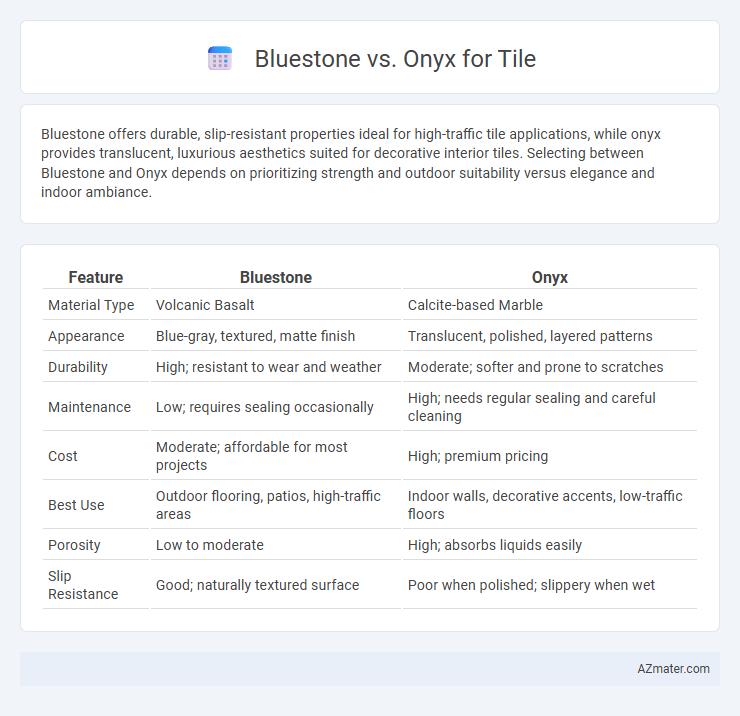Bluestone offers durable, slip-resistant properties ideal for high-traffic tile applications, while onyx provides translucent, luxurious aesthetics suited for decorative interior tiles. Selecting between Bluestone and Onyx depends on prioritizing strength and outdoor suitability versus elegance and indoor ambiance.
Table of Comparison
| Feature | Bluestone | Onyx |
|---|---|---|
| Material Type | Volcanic Basalt | Calcite-based Marble |
| Appearance | Blue-gray, textured, matte finish | Translucent, polished, layered patterns |
| Durability | High; resistant to wear and weather | Moderate; softer and prone to scratches |
| Maintenance | Low; requires sealing occasionally | High; needs regular sealing and careful cleaning |
| Cost | Moderate; affordable for most projects | High; premium pricing |
| Best Use | Outdoor flooring, patios, high-traffic areas | Indoor walls, decorative accents, low-traffic floors |
| Porosity | Low to moderate | High; absorbs liquids easily |
| Slip Resistance | Good; naturally textured surface | Poor when polished; slippery when wet |
Introduction to Bluestone and Onyx Tiles
Bluestone and Onyx tiles are popular natural stone options distinguished by their unique compositions and appearances. Bluestone, a dense, durable sandstone, offers a matte finish with earthy blue-gray tones, ideal for both indoor and outdoor applications. Onyx, a translucent carbonate stone, features vibrant, swirling patterns and a polished surface that enhances its dramatic aesthetics, often used in accent walls and decorative installations.
Bluestone Tile: Overview and Characteristics
Bluestone tile, quarried primarily from sandstone and limestone deposits, is celebrated for its durability, natural slip resistance, and earthy blue-gray tones that range from light to deep hues, making it ideal for outdoor patios and indoor flooring. Its dense composition provides excellent thermal properties and resistance to weathering, ensuring long-lasting performance in high-traffic areas and diverse climates. Bluestone's textured surface and natural cleft finish enhance traction and aesthetic appeal, distinguishing it from the smoother, often more polished onyx tile used typically for decorative wall applications.
Onyx Tile: Overview and Characteristics
Onyx tile is prized for its translucent beauty and unique veining, creating an elegant and luxurious aesthetic in interior design. This natural stone is softer and more porous than bluestone, requiring careful sealing and maintenance to preserve its glossy finish and prevent damage. Onyx tile is commonly used for decorative wall applications, countertops, and backsplashes where its light-reflecting properties enhance the ambiance.
Aesthetic Differences: Bluestone vs Onyx
Bluestone features a natural, matte finish with earthy tones ranging from blue-gray to green, offering a rugged, understated elegance ideal for outdoor and rustic interiors. Onyx showcases a translucent, polished surface with striking veining and vibrant colors like white, amber, and green, making it a luxurious choice for statement walls and sophisticated spaces. The contrast lies in Bluestone's subtle texture and muted palette versus Onyx's glossy, dramatic appearance that enhances light and depth.
Durability and Strength Comparison
Bluestone offers excellent durability with high resistance to weathering and wear, making it ideal for outdoor tiles exposed to varying conditions. Onyx, while visually stunning with its unique translucency, is softer and more prone to scratches and chips, reducing its suitability for high-traffic or heavy-use areas. For applications demanding superior strength and long-lasting performance, bluestone typically outperforms onyx in tile durability.
Installation Process for Bluestone and Onyx Tiles
Bluestone tiles require meticulous surface preparation to ensure proper adhesion, often involving a level substrate and a suitable primer to prevent moisture issues. Onyx tiles demand a more delicate installation process due to their translucency and fragility, necessitating expert handling with specialized adhesives and backlighting considerations for aesthetic enhancement. Both materials benefit from professional installation to maintain durability and achieve the intended visual appeal.
Maintenance Requirements
Bluestone tiles require regular sealing to prevent water absorption and staining, especially in high-traffic or outdoor areas, while onyx tiles need more delicate care due to their porous nature and susceptibility to scratching and etching. Bluestone maintenance involves periodic cleaning with pH-neutral cleaners and prompt removal of spills to maintain its durability. Onyx demands gentle cleaning with specialized stone care products and avoidance of acidic or abrasive substances to preserve its polished surface and vibrant patterns.
Cost Analysis: Bluestone vs Onyx
Bluestone typically costs between $5 to $10 per square foot, making it an affordable choice for natural stone tiles, while onyx prices range significantly higher, from $15 to $30 per square foot, due to its rarity and unique translucent properties. Installation costs for onyx are also steeper, often 20-30% more expensive than bluestone, given its fragility and the need for skilled labor. Maintenance expenses further impact total cost, with onyx requiring specialized sealing and repair, whereas bluestone's durability results in lower long-term upkeep costs.
Best Applications for Each Tile Type
Bluestone offers exceptional durability and slip resistance, making it ideal for outdoor patios, walkways, and pool surrounds where weather resistance is crucial. Onyx, with its striking translucency and intricate veining, excels in interior applications such as feature walls, countertops, and backlit installations to highlight its natural beauty. Both stone types provide unique aesthetic and functional benefits that cater to different design needs and environmental conditions.
Choosing the Right Tile: Bluestone or Onyx?
Bluestone offers durability and slip resistance ideal for high-traffic areas and outdoor applications, while onyx provides a luxurious, translucent appearance suitable for indoor accent walls and low-traffic spaces. Choosing between bluestone and onyx depends on the desired aesthetic and functional requirements, with bluestone excelling in strength and weather resistance and onyx prized for its unique, elegant veining and light-diffusing properties. Consider maintenance needs as bluestone requires minimal upkeep, whereas onyx demands careful sealing and protection from scratches and stains.

Infographic: Bluestone vs Onyx for Tile
 azmater.com
azmater.com